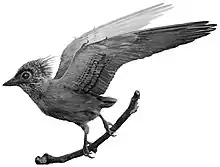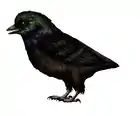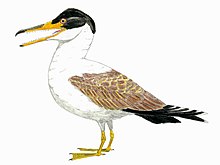| Neimongosaurus Temporal range: Late Cretaceous, ~ | |
|---|---|
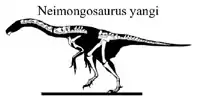 | |
| Skeletal reconstruction | |
| Scientific classification | |
| Domain: | Eukaryota |
| Kingdom: | Animalia |
| Phylum: | Chordata |
| Clade: | Dinosauria |
| Clade: | Saurischia |
| Clade: | Theropoda |
| Superfamily: | †Therizinosauroidea |
| Family: | †Therizinosauridae |
| Genus: | †Neimongosaurus Zhang et al 2001 |
| Type species | |
| †Neimongosaurus yangi Zhang et al 2001 | |
Neimongosaurus (meaning "Nei Mongol lizard") is a genus of herbivorous therizinosaur theropod dinosaur that lived in Asia during the Cenomanian stage of the Late Cretaceous period in what is now the Iren Dabasu Formation.
Discovery and naming
Neimongosaurus is a therizinosauroid which is known from the holotype LH V0001, consisting of a partially preserved braincase; the front of the right lower jaw; a nearly complete axial column compromising 15 cervical (including the axis), 4 dorsal and 22 caudal vertebrae; a furcula; both scapulocoracoids; both humeri; left radius; fragmented ilia; both femora; both tibiae; left tarsals and a virtually complete and articulated left pes. A second specimen, LH V0008, consisting of a sacrum composed by 6 sacral vertebrae and both ilia, was assigned as the paratype. The specimens were collected in 1999 at Sanhangobi in Inner Mongolia from the Iren Dabasu Formation, dating from the Cenomanian stage.[1]
Based on these remains, the type species, Neimongosaurus yangi, was formally named and described by Zhang Xiaohong, Xu Xing, Paul Sereno, Kwang Xuewen and Tan Lin in 2001. The generic name is derived from Nei Mongol, the Chinese name for Inner Mongolia. The specific name honours Yang Zhongjian.[1]
Description
Neimongosaurus is thought to have been a small-sized therizinosaur, from 2.3 to 3 m (7.5 to 9.8 ft) in length and weighing 91 to 227 kg (201 to 500 lb).[2][3]
Neimongosaurus was a bipedal and ponderous animal with well developed hindlimbs. The femur measured 36.6 cm (366 mm) long, having a straight shaft, the femoral head points to the inner sides. Both tibiae are preserved, measuring 31 cm (310 mm); shorter than the femur. Its lower jaw is U-shaped, preserving only a partial right dentary. There are 5 alveoli in which only one tooth was preserved. It is coarsely serrated, indicating a herbivorous diet like other therizinosaurs, such as Alxasaurus or Erlikosaurus. It had a relatively elongated neck composed by approximately 16 cervicals (if preserved atlas). Overall, the forelimbs are well preserved, missing the manus. Its scapula had a tapering end.[1]
Classification
The original describers of the genus assigned Neimongosaurus to the Therizinosauroidea, in a basal position.[1] Subsequent cladistic analyses have indicated a position in the more derived Therizinosauridae,[4] but an analysis in 2010 by Lindsay Zanno recovered the original placement.[5] However, Hartman et al. 2019 recovered Neimongosaurus as a therizinosaurid again. Below are the results:[6]
| Therizinosauridae |
| |||||||||||||||||||||||||||||||||||||||||||||||||||||||||
Paleobiology
In a 2006 conference abstract, Sara Burch presented the inferred range of motion in the arms of the therizinosaur Neimongosaurus and concluded the overall motion at the glenoid-humeral joint at the shoulder was roughly circular, and directed sideways and slightly downwards, which diverged from the more oval, backwards-and-downwards-directed ranges of other theropods. This ability to extend their arms considerably forwards may have helped Neimongosaurus reach and grasp for foliage.[7]
See also
References
- 1 2 3 4 Zhang, X.-H.; Xu, X.; Zhao, Z.-J.; Sereno, P. C.; Kuang, X.-W.; Tan, L. (2001). "A long-necked therizinosauroid dinosaur from the Upper Cretaceous Iren Dabasu Formation of Nei Mongol, People's Republic of China" (PDF). Vertebrata PalAsiatica. 39 (4): 282–290.
- ↑ Holtz, T. R.; Rey, L. V. (2007). Dinosaurs: The Most Complete, Up-to-Date Encyclopedia for Dinosaur Lovers of All Ages. Random House. ISBN 9780375824197.
{{cite book}}: CS1 maint: date and year (link) Genus List for Holtz 2012 Weight Information - ↑ Paul, G. S. (2016). The Princeton Field Guide to Dinosaurs (2nd ed.). Princeton, New Jersey: Princeton University Press. pp. 151−152. ISBN 9780691167664.
- ↑ Senter, P. (2007). "A new look at the phylogeny of coelurosauria (Dinosauria: Theropoda)". Journal of Systematic Palaeontology. 5 (4): 429–463. doi:10.1017/S1477201907002143. S2CID 83726237.
- ↑ Zanno, L. E. (2010). "A taxonomic and phylogenetic re-evaluation of Therizinosauria (Dinosauria: Maniraptora)". Journal of Systematic Palaeontology. 8 (4): 503–543. doi:10.1080/14772019.2010.488045. S2CID 53405097.
- ↑ Hartman, S.; Mortimer, M.; Wahl, W. R.; Lomax, D. R.; Lippincott, J.; Lovelace, D. M. (2019). "A new paravian dinosaur from the Late Jurassic of North America supports a late acquisition of avian flight". PeerJ. 7: e7247. doi:10.7717/peerj.7247. PMC 6626525. PMID 31333906.
- ↑ Burch, S. H. (2006). "The range of motion of the glenohumeral joint of the therizinosaur Neimongosaurus yangi (Dinosauria: Theropoda)". Journal of Vertebrate Paleontology. 26 (supp. 3): 46A. doi:10.1080/02724634.2006.10010069. S2CID 220413406.


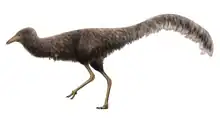

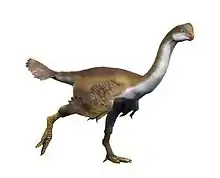
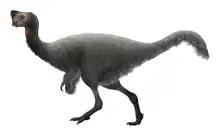
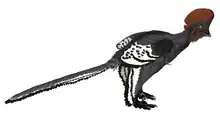


.png.webp)


.jpg.webp)
